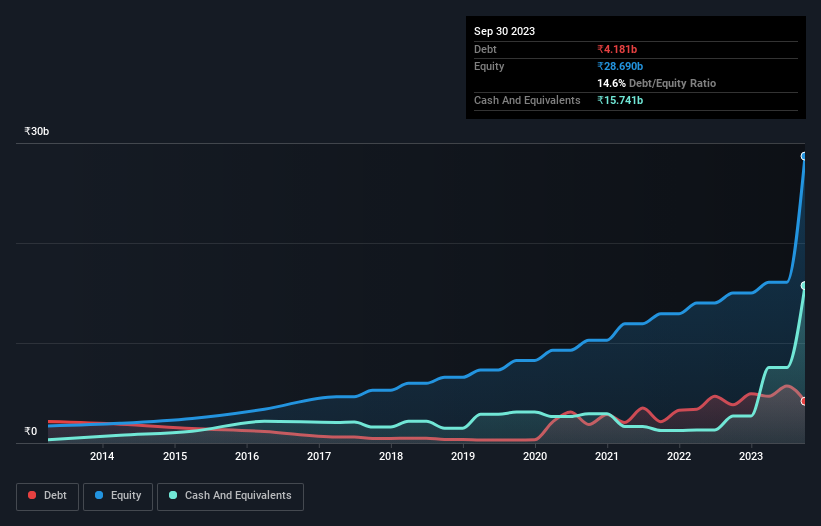Warren Buffett famously said, 'Volatility is far from synonymous with risk.' It's only natural to consider a company's balance sheet when you examine how risky it is, since debt is often involved when a business collapses. As with many other companies Sheela Foam Limited (NSE:SFL) makes use of debt. But should shareholders be worried about its use of debt?
When Is Debt Dangerous?
Debt assists a business until the business has trouble paying it off, either with new capital or with free cash flow. If things get really bad, the lenders can take control of the business. However, a more frequent (but still costly) occurrence is where a company must issue shares at bargain-basement prices, permanently diluting shareholders, just to shore up its balance sheet. Of course, debt can be an important tool in businesses, particularly capital heavy businesses. When we examine debt levels, we first consider both cash and debt levels, together.
Check out our latest analysis for Sheela Foam
What Is Sheela Foam's Net Debt?
You can click the graphic below for the historical numbers, but it shows that as of September 2023 Sheela Foam had ₹4.18b of debt, an increase on ₹3.82b, over one year. However, it does have ₹15.7b in cash offsetting this, leading to net cash of ₹11.6b.

How Healthy Is Sheela Foam's Balance Sheet?
The latest balance sheet data shows that Sheela Foam had liabilities of ₹6.98b due within a year, and liabilities of ₹4.41b falling due after that. Offsetting these obligations, it had cash of ₹15.7b as well as receivables valued at ₹2.92b due within 12 months. So it actually has ₹7.27b more liquid assets than total liabilities.
This short term liquidity is a sign that Sheela Foam could probably pay off its debt with ease, as its balance sheet is far from stretched. Simply put, the fact that Sheela Foam has more cash than debt is arguably a good indication that it can manage its debt safely.
On the other hand, Sheela Foam's EBIT dived 11%, over the last year. If that rate of decline in earnings continues, the company could find itself in a tight spot. The balance sheet is clearly the area to focus on when you are analysing debt. But ultimately the future profitability of the business will decide if Sheela Foam can strengthen its balance sheet over time. So if you want to see what the professionals think, you might find this free report on analyst profit forecasts to be interesting.
Finally, a company can only pay off debt with cold hard cash, not accounting profits. Sheela Foam may have net cash on the balance sheet, but it is still interesting to look at how well the business converts its earnings before interest and tax (EBIT) to free cash flow, because that will influence both its need for, and its capacity to manage debt. In the last three years, Sheela Foam created free cash flow amounting to 13% of its EBIT, an uninspiring performance. For us, cash conversion that low sparks a little paranoia about is ability to extinguish debt.
Summing Up
While it is always sensible to investigate a company's debt, in this case Sheela Foam has ₹11.6b in net cash and a decent-looking balance sheet. So we are not troubled with Sheela Foam's debt use. When analysing debt levels, the balance sheet is the obvious place to start. However, not all investment risk resides within the balance sheet - far from it. We've identified 1 warning sign with Sheela Foam , and understanding them should be part of your investment process.
If, after all that, you're more interested in a fast growing company with a rock-solid balance sheet, then check out our list of net cash growth stocks without delay.
New: Manage All Your Stock Portfolios in One Place
We've created the ultimate portfolio companion for stock investors, and it's free.
• Connect an unlimited number of Portfolios and see your total in one currency
• Be alerted to new Warning Signs or Risks via email or mobile
• Track the Fair Value of your stocks
Have feedback on this article? Concerned about the content? Get in touch with us directly. Alternatively, email editorial-team (at) simplywallst.com.
This article by Simply Wall St is general in nature. We provide commentary based on historical data and analyst forecasts only using an unbiased methodology and our articles are not intended to be financial advice. It does not constitute a recommendation to buy or sell any stock, and does not take account of your objectives, or your financial situation. We aim to bring you long-term focused analysis driven by fundamental data. Note that our analysis may not factor in the latest price-sensitive company announcements or qualitative material. Simply Wall St has no position in any stocks mentioned.
About NSEI:SFL
Sheela Foam
Engages in the manufacture and sale of polyurethane foams and mattresses in India and internationally.
Reasonable growth potential with imperfect balance sheet.
Similar Companies
Market Insights
Community Narratives



